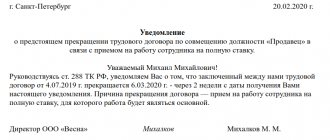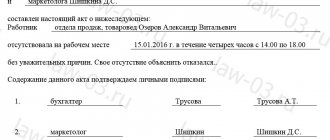What does dismissal due to reduction mean?
Officially, dismissal due to reduction is called “termination of an employment contract due to a reduction in the number or staff of employees” (clause 2, part 1, article of the Labor Code of the Russian Federation).
Not only companies, but also entrepreneurs-employers can lay off employees. When staffing is reduced, one or more positions are completely eliminated, excluding them from the staffing table.
Create a staffing table using a ready-made template Try for free
For example, a company that no longer intends to sell retail closes a store and eliminates the positions of salesperson, cashier, and store manager from the staffing table. Accordingly, those who occupy these positions are either transferred to another job or laid off due to layoffs.
When staffing is reduced, the list of positions in the staffing table remains unchanged. However, the number of employees in one position or another is decreasing. For example, due to the liquidation of several retail outlets, instead of five sellers, there are only three. Those who are “extra” are transferred to other positions or made redundant.
IMPORTANT. There are no fundamental differences in the dismissal procedure depending on what exactly is being reduced - the number of positions or the number of employees. Moreover, these dismissals can be carried out simultaneously. In this case, some positions are completely removed from the staffing table, while for others the number of staff units is reduced.
Stages of the procedure
The sequence of actions for early dismissal from a position is almost identical to the standard termination of employment contracts. Step-by-step algorithm:
- Employee statement.
- Leader's order.
- Recording in labor.
Having considered the subordinate’s request for early dismissal due to reduction before the expiration of the notice period, the manager satisfies it or refuses it, setting special conditions. A resolution is placed on the application. A positive response means the issuance of a new order, on the basis of which the accounting department will calculate the due payments. All funds are given to the former employee on the day of dismissal, which he himself indicated in the application.
Early departure in the context of a change in the number of staff requires the employee to competently draw up an application. A sample petition for termination of employment can be easily found on the Internet, but it is important not to blindly follow the template, but to note three main points. Firstly, it is necessary to agree with the fact of dismissal due to reduction, secondly, indicate early departure in connection with this and, thirdly, declare a demand for all payments.
The employer has no legal reason to refuse a person resigning early due to layoffs, but may impose certain conditions. For example, ask for the completion of current tasks and the transfer of documentation to the responsible person of the employer. This must be a voluntary agreement between the manager and the employee. The law allows no more than two weeks for the implementation of such conditions.
The end of an employee’s obligations is recorded by an entry in the labor record. A book with the appropriate marking is issued to the former employee on the day of dismissal. Example of an entry: relieved of duty due to staff reduction.
Who cannot be fired during a staff reduction?
It is prohibited to dismiss pregnant women, as well as women with children under the age of three, as well as single mothers raising children under the age of 14 (a disabled child under the age of 18). Also on the “prohibited” list are any employees who raise a child under 14 years of age (a disabled child under 18 years of age) without a mother, or are the sole breadwinner of a disabled child under 18 years of age. In addition, it is impossible to lay off an employee who has a child under three years of age if the family has three or more children under 14 years of age and the second parent (legal representative) does not work (Article 261 and Article 264 of the Labor Code of the Russian Federation ).
ATTENTION. When laying off employees with children, it is necessary to check not only the age of the child, but also the composition of the family.
In addition, there are categories of employees who cannot be dismissed due to redundancy within a certain period of time. For example, Part 6 of Article of the Labor Code of the Russian Federation prohibits layoffs of those who are on sick leave or on vacation. It will be possible to dismiss an employee after the end of illness or vacation. Another example is employees who are members of an election commission with advisory voting rights. The reduction will have to wait until the end of the election campaign (Clause 19, Article 29 of the Federal Law of June 12, 2002 No. 67-FZ).
It is also impossible to lay off those who received the right to keep their jobs based on the results of an assessment conducted by the employer. Let us remind you that according to the rules of Article 179 of the Labor Code of the Russian Federation, employees with higher labor productivity and qualifications have a preferential right to remain at work. And with equal productivity and qualifications, the following persons can apply for protection from reduction:
- family workers with at least two dependents;
- the only breadwinners in the family;
- employees who received work-related injuries and occupational diseases during work;
- employees aimed at improving their skills without interruption from work;
- disabled people of the Second World War and combat operations to defend the Fatherland;
- Chernobyl workers who received or suffered “radiation” diseases;
- other employees who are granted such a right by the collective agreement.
Before deciding to downsize (especially when it comes to downsizing), the employer must evaluate employees based on these factors. Based on this assessment, a decision should be made as to whether or not they have a preferential right to retain their position.
Compose HR documents using ready-made templates for free
What payments are due upon redundancy?
First of all, these are standard payments that are due to any resigning employee. Namely: wages for hours worked, bonuses, as well as compensation for unused vacation (the calculation of compensation in this case has its own peculiarities). Also, laid-off workers may qualify for additional amounts of money.
Vacation pay compensation
Employees who have worked more than five and a half months in the working year at the time of layoff can count on full compensation for unused vacation. This means that if the dismissed person did not take vacation days at all for the current working year, then he receives compensation for the full vacation (i.e. for all 28 calendar days). If part of the vacation has already been used, then compensation is paid for unused days of full vacation for this working year (subparagraph “a”, paragraph 28 of the Rules on regular and additional vacations, approved by the People's Commissar of the USSR on April 30, 1930 No. 169). For example, if an employee has worked for more than five and a half months, but has already taken 5 days off from his current vacation, then if he is laid off, he will receive compensation for the remaining 23 days.
ATTENTION. In some regions, the courts insist that the described algorithm must be applied to all laid-off employees, and not just those who have been working for the first year (see, for example, the Bulletin of judicial practice of the Moscow Regional Court for the fourth quarter of 2015, the appeal ruling of the Irkutsk Regional Court dated 11/12/14 in case No. 33-9318/2014). And although Rostrud gives explanations to the contrary (letters dated 03/04/13 No. 164-6-1 and dated 08/09/11 No. 2368-6-1), before paying “old” workers compensation according to the usual rules, you should weigh the pros and cons "against". In this case, you need to take into account the prospects for possible litigation and the practice that is developing in your region.
Severance pay
All employees have the right to receive it, with the exception of those with whom an agreement was concluded for a period of up to two months. The latter is entitled to severance pay only if it is provided for in a collective or labor agreement (Article 292 of the Labor Code of the Russian Federation).
The amount of the benefit depends on the category of the dismissed employee. “Ordinary” employees are paid an amount equal to the average monthly earnings (Article 178 and Article 318 of the Labor Code of the Russian Federation). Seasonal workers receive smaller compensation - based on two-week average earnings (Article 296 of the Labor Code of the Russian Federation).
Calculate your salary and benefits taking into account the increase in the minimum wage from 2021 Calculate for free
Two-month compensation
If a laid-off employee does not find a new job within a month after dismissal, then he retains his average earnings for the next month. It is paid by the former employer on regular salary payment days (clause 12 of the Regulations, approved by Resolution of the USSR State Committee for Labor, the Secretariat of the All-Union Central Council of Trade Unions dated March 2, 1988 No. 113/6-64). This procedure applies only to “regular” employees. Seasonal and temporary workers do not have the right to additional payments for the period of employment (Article 292 of the Labor Code of the Russian Federation and Article 296 of the Labor Code of the Russian Federation).
Average earnings for the second month after dismissal are paid based on the employee’s passport and work record book. If there is no record of hiring a new job at all, then the average salary is transferred to the redundant employee in full. If there is a record of employment, but it is not dated at the beginning of the month, then the average salary must be paid for the days preceding this date (Article 178 of the Labor Code of the Russian Federation), appeal ruling of the Omsk Regional Court dated September 12, 2012 in case No. 33-5536 /2012).
The right to receive money for the third month after layoff is confirmed not by a work book, but by an official document from the employment service (Part 2 of Article 178 of the Labor Code of the Russian Federation). The employer can appeal this document if he considers it unlawful (clause 2.2 of the ruling of the Constitutional Court of the Russian Federation of November 29, 2012 No. 2214-O, part 1 of article 218 of the Constitutional Court of the Russian Federation). Filing such a complaint does not exempt a former employee from paying money (this follows from Article 236 of the Labor Code of the Russian Federation and Article 5.27 of the Code of Administrative Offenses of the Russian Federation). However, if the court finds the decision of the employment service illegal, the funds paid will be compensated to the employer from the budget.
IMPORTANT. Is it necessary to subject average earnings during the period of employment to personal income tax and insurance contributions? The answer to this question depends on the total amount of payments transferred in favor of the laid-off employee, taking into account severance pay. If the entire amount does not exceed three times the employee’s average monthly earnings, then there is no need to charge contributions and withhold personal income tax. Otherwise, contributions will have to be charged on the excess amounts and tax will be withheld from these amounts (clause 3 of Article 217 of the Tax Code of the Russian Federation and subclause 2 of clause 1 of Article 422 of the Tax Code of the Russian Federation, subclause 2 of clause 1 of Article 20.2 of the Federal Law of July 24 .98 No. 125-FZ).
Generate payment slips for personal income tax and contributions with current details Try for free
Possible violations by the employer upon early termination of the contract
One of the most common tricks on the part of the employer during dismissal is pressure on the employee to formalize the early termination of the employment relationship at his own request or by agreement of the parties.
In this case, the company will be able to save on additional payments, because no compensation is provided for the employee for such reasons for parting with the employer.
Attention
The employee should clearly write in his resignation letter the conditions under which he agrees to terminate the contract and what payments he is entitled to. Thus, he will protect himself from abuse by the employer.
In addition, the organization should understand that any pressure on an employee to make a decision beneficial to the company is illegal and can lead to negative consequences. In particular, forcing the employee to terminate the contract at his own request, through psychological influence on the employee, will most likely lead to litigation.
Payments for staff reduction in 2021: calculation procedure
To calculate the amount of severance pay, you must first determine the average daily earnings. It is calculated in a general manner based on the employee’s salary data for the previous 12 months. If the reduction occurs on the last day of the month, then this month is also included in the billing period (letter of Rostrud dated July 22, 2010 No. 2184-6-1). In other cases, the calculation is carried out according to the previous month (clause 4 of the Regulations on the specifics of the procedure for calculating the average salary, approved by Decree of the Government of the Russian Federation of December 24, 2007 No. 922; hereinafter referred to as the Regulations).
The specific amount of severance pay is determined by multiplying the average daily earnings by the number of working and non-working holidays in the first month after dismissal (Resolution of the Constitutional Court of the Russian Federation of November 13, 2019 No. 34-P). If we are talking about seasonal workers, then the average daily earnings must be multiplied by the number of working days and non-working holidays that fall in the two weeks following dismissal.
ATTENTION. Severance pay is paid for both working days and holidays.
There are nuances when calculating payments to employees for whom summarized working time recording is established. Here you need to calculate not the average daily earnings, but the average hourly earnings (clause 13 of the Regulations). The resulting value must be multiplied by the number of working hours according to the employee’s schedule in the first month (for seasonal workers - in the first two weeks) after dismissal. This means that for the purpose of calculating severance pay, it is necessary to draw up a schedule as if the dismissed employee continues to work.
Calculate all payments taking into account personal income tax for the dismissed employee
Nuances of the early dismissal procedure
Early termination of a contract due to staff reduction is permitted in the case when the subjects of labor relations have reached an agreement, that is:
- at the initiative of the employer (the employer made a proposal to which the employee agreed);
- at the initiative of the employee (the employee expressed a desire to terminate the contract early, and the employer agreed to this condition).
In this case, dismissal will occur as follows:
- written information to the employee about the upcoming reduction in the organization;
- offering alternative positions to the dismissed person;
- mutual agreement (on any initiative) to terminate the contract early;
- agreeing on the date of dismissal;
- issuance of an order;
- issuance of documents and payment of settlement.
Payment of compensation for early dismissal is carried out at the request of the employee.
This is important to know! Agreeing on a new term for termination of the contract is not an obligation of the employer, but only a right. There is no guarantee that the employer will be able to part with the employee at any time.
What payments are not included in the calculation?
When calculating the average daily (hourly) earnings, on the basis of which the amount of severance pay is determined, it is not necessary to take into account social payments not related to wages. These, in particular, include financial assistance, compensation for the cost of food, travel, training, utilities, recreation, and others (clause 3 of the Regulations).
You must also remember that amounts accrued during the time when the employee did not work are excluded from the billing period. In particular, sick leave is not taken into account, including maternity benefits, remuneration for downtime, payment for additional days to care for disabled children and people with disabilities since childhood. In addition, when calculating, it is necessary to exclude accruals made during the time when the employee did not work (participated in military training, court hearings, investigative actions, etc.). This is stated in paragraph 5 of the Regulations.
Features of payments for certain categories of workers
Pensioners
There is no special procedure for dismissal of pensioners. Therefore, parting with them on this basis occurs according to general rules. This means that pensioners have the right to receive the same payments as other “ordinary” laid-off workers (cassation ruling of the Yaroslavl Regional Court dated June 10, 2010 in case No. 33-2930).
REFERENCE. A pensioner dismissed due to layoff must be paid a salary and bonus for time worked, compensation for unused vacation and severance pay. He also has the right to receive average earnings for the second month after dismissal (in certain situations and for subsequent months), if he does not find a new job during this time (letter of Rostrud dated December 28, 2005 No. 2191-6-2, ruling of the Moscow City Court dated April 4. 16 No. 4g-2964/2016).
Workers on probation
There are no provisions for laying off workers who are on a probationary period. However, when calculating compensation for unused vacation, the following must be taken into account.
In general, the probationary period lasts no more than 3 months (Article of the Labor Code of the Russian Federation). Consequently, an employee who is laid off during the probationary period will not be able to claim full compensation for unused vacation for the entire year. Compensation should be calculated in proportion to the time worked.
For certain categories of employees (managers and their deputies, chief accountants and their deputies, heads of separate divisions) it is allowed to establish a probationary period of six months. Therefore, a situation is possible when, on the date of layoff, such a “subject” worked in the current working year for more than five and a half months. In this case, he has the right to count on compensation for full vacation (provided that he has not previously used this vacation or part of it).
Residents of the Far North
When laying off employees of an organization located in the Far North or an equivalent area, additional guarantees are established. Thus, the average earnings for the period of employment can be maintained not only for the second and third months after dismissal, but also for the fourth to sixth months. In this case, special rules apply for the transfer of these amounts.
Calculate your salary taking into account all current local and regional coefficients and allowances
Thus, payments for the second and third months are made by the former employer on the basis of the employee’s work book and passport. Confirmation from the employment service is required only if the dismissed person wants to receive average earnings for the fourth to sixth months (Part 2 of Article 318 of the Labor Code of the Russian Federation).
IMPORTANT. When transferring payments to persons dismissed from “northern” organizations, you need to remember tax preferences. The total amount of payments (including severance pay), not exceeding six times the average salary of a laid-off employee, is not subject to personal income tax and insurance contributions. And only from the excess amount will it be necessary to withhold income tax and charge insurance premiums on this amount (clause 3 of Article 217 of the Tax Code of the Russian Federation and subclause 2 of clause 1 of Article 422 of the Tax Code of the Russian Federation, subclause 2 of clause 1 of Article 20.2 of the Law No. 125-FZ).
The guarantees provided for workers dismissed from organizations located in the Far North or equivalent areas do not apply to part-time workers (Article 287 of the Labor Code of the Russian Federation). This means that “northerners” - part-time workers cannot count on payment for the fourth to sixth month after dismissal. But are they entitled to payments for the second and third months? Let's figure it out.
Part-timers
As mentioned above, the average salary for the second month after a layoff is paid based on the work record book. And the work book of a part-time worker (if it is kept in paper form) must be kept by his main employer (Article of the Labor Code of the Russian Federation).
Part-time work means performing one more job, which is additional to the main one (Article 282 of the Labor Code of the Russian Federation). This means that even after the layoff, the part-time worker remains employed (letter of the Ministry of Labor dated 08/03/18 No. 14-1/ОOG-6309).
Thus, in a normal situation, a part-time worker cannot claim to receive average earnings for the second, and especially for the third month after dismissal. However, in practice there may be exceptions.
Thus, labor legislation does not prohibit drawing up a contract for part-time work in the absence of a main job. Nor does it oblige you to stop part-time work or re-register it as your main job if the employee has already lost his main job during the part-time job.
Draw up and print an employment contract
In such situations, a part-time worker laid off due to layoffs becomes unemployed and can receive average earnings for the period of employment. To do this, he has a work book in his hands, in which there is no record of employment (cassation ruling of the Rostov Regional Court dated 10/17/11 in case No. 33-14084, ruling of the Moscow City Court dated 01/30/12 in case No. 33-2395).
Other payments (salaries, bonuses, compensation for unused vacation, severance pay) are transferred to part-time workers on a general basis.
Early layoff
The employee must be notified at least 2 months in advance of an upcoming dismissal due to a reduction in numbers or staff. If the employee and employer agree, dismissal can be formalized before the end of this period. In this case, the employee is entitled to additional compensation (Article 180 of the Labor Code of the Russian Federation).
IMPORTANT. Receiving compensation for early dismissal does not deprive the employee of the right to severance pay, as well as to payment of average earnings for the period of employment.
Additional compensation is calculated as follows. First, you need to determine the average daily (if working time is calculated hourly) earnings of the laid-off employee based on data for the previous 12 months. The resulting value should be multiplied by the number of working days (with cumulative accounting - hours) that fall after the day of “early” dismissal and before the day of “planned” layoff (Part 3 of Article 180 of the Labor Code of the Russian Federation).
Additional compensation, like other amounts due upon dismissal, is paid on the last day of work upon final payment (part 4 of article 84.1 of the Labor Code of the Russian Federation, part 1 of article 140 of the Labor Code of the Russian Federation). This compensation in full is not subject to personal income tax or insurance contributions (letters from the Ministry of Finance dated 03.08.17 No. 03-04-06/49795 and dated 31.07.17 No. 03-04-07/48592, Federal Tax Service dated 21.08.17 No. BS- 4-11/ [email protected] ).
It happens that after receiving a notice of dismissal due to reduction, an employee decides to terminate the employment contract on his own initiative. In this case, it is enough for him to submit a letter of resignation of his own free will. However, he will not receive any additional payments, including severance pay and average earnings for the months after dismissal. Therefore, in order to avoid conflict situations, we recommend that you notify the resigning employee of such consequences against signature.
Appealing in court against unlawful actions of an employer
The legislator obliges employers to notify about impending layoffs 2 months in advance. The remaining period until the designated day of dismissal, the person works in a standard mode. Unfortunately, even today there are stories where employees leave early “on their own initiative” before the official layoff date under pressure from their employers.
It is important to know! The right to submit a complaint to the court is retained for 3 months from the day the final payment was made (Article 392 of the Labor Code). It is very important not to miss the specified deadline.
Obtaining the payments due in court depends on the ability to prove the presence of coercion on the part of management. And this is very difficult. When considering such claims, the court will carefully study all the details:
- the reasons that prompted you to apply for dismissal;
- the circumstances under which it was compiled;
- the employee's true intentions;
- the text of the resignation letter, including the presence of details (signature, date, employer’s resolution).
If a former employee can prove coercion to submit an application for resignation, then the latter will be declared illegal. In this case, the employer is obliged to change the official reason for dismissal and make a calculation taking into account all compensation due, including moral damages and legal costs of the former employee. At its discretion and at the request of the employee, the court may reinstate him in his previous position and oblige the employer to pay for the forced absence.










